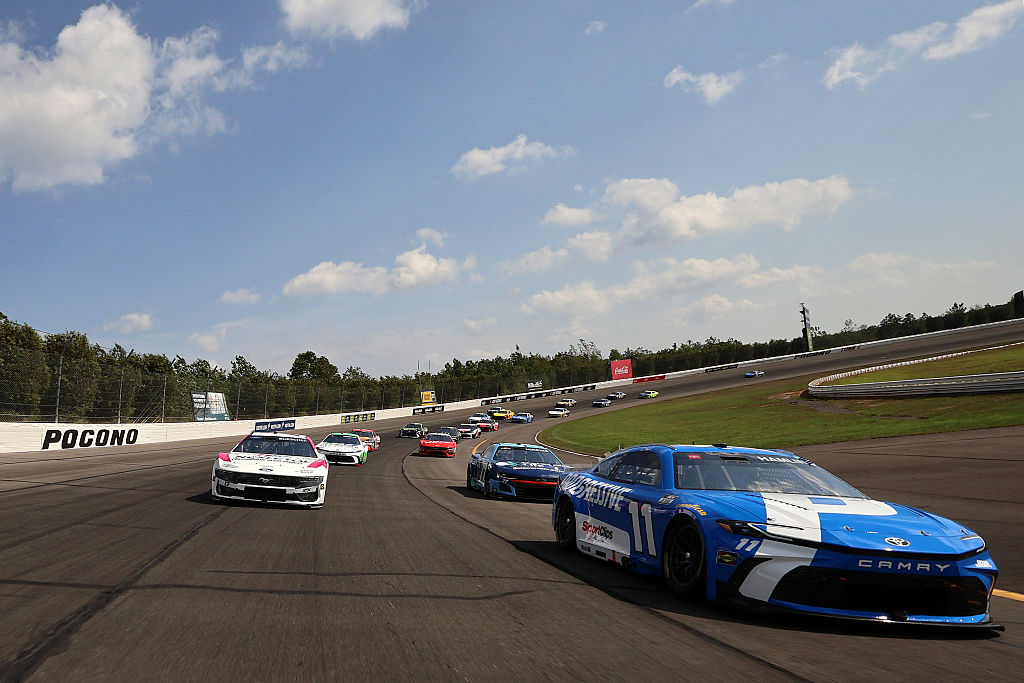Denny Hamlin’s Challenge at Pocono Raceway: A Race Recap
Denny Hamlin had a promising chance to secure a victory at Pocono Raceway on Sunday, but things didn’t go as planned. Despite being in a strong position, he ultimately finished behind his Joe Gibbs Racing teammate, Chase Briscoe, who employed a fuel-saving strategy in the final laps of the race.
The Race Dynamics
As the race unfolded, Hamlin found himself alongside Briscoe on the front row for the restart. However, Briscoe faced a significant challenge, as he was low on fuel, having exited the pit stall before the refueling was complete. This situation led to a tense and strategic battle between the two drivers in the closing laps.
The restart on lap 130 marked a pivotal moment in the race. Briscoe needed to carefully manage his pace, ensuring that he didn’t push his car too hard and risk running out of fuel. Meanwhile, Hamlin was keenly aware of the fuel situation. His crew chief, Chris Gayle, kept him informed, though he later admitted uncertainty about whether Briscoe would make it to the finish without running out of gas.
“It was the best kind of option,” Hamlin remarked about his position during the race. He recognized the difficulty of the situation, particularly after several competitors, including the car number 19, made their pit stops just before a caution came out, allowing them to leapfrog ahead in the race. At that moment, Hamlin understood that regaining lost track position would be a daunting task.
Mid-Race Strategy
A debris caution late in the second stage prompted most of the drivers to head to pit road for fresh tires and fuel. However, Briscoe, along with five other drivers, opted to stay on the track. This decision proved to be a game-changer, as Briscoe seized the lead on the restart and secured the stage victory, while Hamlin managed to position himself in sixth place. The strategic decisions made by both drivers significantly influenced the race’s outcome.
The final caution, occurring with just 36 laps remaining, shifted the race’s momentum. It coincided with a series of green flag pit stops, during which Briscoe and Hamlin had already completed their final stops, allowing them to cycle back to the front of the field. This situation set the stage for a thrilling finish to the race.
Hamlin’s Performance
Hamlin started the race from the pole position and led for 32 laps, showcasing his prowess on the track. He also claimed victory in the first stage of the race, demonstrating strong performance throughout the event. Over the last three races, he has consistently finished in the top three, underscoring his competitiveness this season.
“We’re really strong,” Hamlin stated confidently after the race. “Not showing up with any weakness right now. I’m really proud of the effort we put forth and just love to get more wins. But still, it was a good overall solid day for us, and now we move on to the next series of races.”
The Importance of Team Strategy
The intricacies of race strategy played a crucial role in determining the outcome of the Pocono event. Both Hamlin and Briscoe had to navigate not only their own strategies but also anticipate the moves of other drivers on the track. The decision-making process in the pit, especially concerning when to pit and when to stay out, became a defining factor in the race.
Briscoe’s choice to remain on the track during the second stage’s debris caution was a calculated risk that ultimately paid off, allowing him to gain valuable track position. Hamlin’s team also executed their strategy well, but the timing of the caution and subsequent pit stops left them scrambling to regain ground on the leader.
Looking Ahead
As the NASCAR season progresses, Hamlin’s team continues to build momentum. With several races remaining, drivers are keenly aware that every decision counts, from tire management to fuel strategy. The lessons learned at Pocono will undoubtedly inform their approach in future races.
Hamlin’s ability to maintain a strong performance week after week showcases his experience and skill. It’s essential to consistently adapt to changing race conditions and competitor strategies. As the season evolves, fans and analysts alike will be watching closely to see how Hamlin and his team leverage their strengths.
In conclusion, the Pocono Raceway event highlighted the tight competition in NASCAR and the critical importance of strategy and execution. Hamlin’s experience and determination will serve him well as he continues to navigate the challenges of the season ahead. The next races will be an opportunity for him to build on his current momentum and strive for victory once again.
